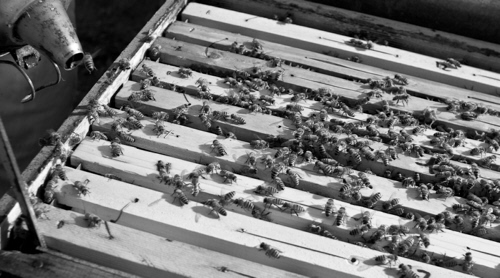Going from Oristano and passing through Campidano and Marmilla, we arrived at Barumini in front of the shop Isca ‘e’ Muras where we met the married couple who are working with apiculture. After having followed them a short distance, we arrived at the place of their beehives where the bees are producing various types of honey at this time of year: white clover and a flower called millefiori meaning a thousand flowers.
Before we could approach the beehives, we had to put on protective clothing including a white jumpsuit, a hood with netting and gloves. Marinella Concu and her husband Marco kindly helped us put on the clothing and closing any openings with tape. After also having explained to us how to behave in order to avoid annoying the bees, we approached the beehives slowly.
Having arrived at the beehives, Marco prepared a device to apply smoke to the bees in order to calm them. Then, while Marinella explained to us some of the routines regarding beekeeping, her husband began to open the beehives. Controlling the beehives started with taking off the lid covering the beehive, making it possible to see if the bees were in good health or not. Below the lid, there was a horizontal plate with a hole in its centre. Just before putting the lid back on, the beekeeper makes a hole in a plastic bag containing nutrients intended to supplement the diet of the bees. Then, he positions the hole of the plastic bag straight above the hole in the plate such that the bees can eat whenever they want. When the lid is opened some time later, if the bag is more or less empty, it’s a sign that the bees are healthy. After having removed the plate with the hole, we could have a look at the “Sardinian” bees. Internally, the beehive consists of a number of parallel, vertical frames, while the frames are supporting beeswax sheets on which the bees live and where they build their famous hexagonal cells. The frames were lifted up and inspected, looking for parasites, presence of drones, the health of the queen and the mood of the bees. Being new to beekeeping, the bees seemed friendly and quiet, apart from some assaults against the camera, which the beekeepers explained was caused by its black colour.
Having finished the inspection of the beehives, we went to another set of beehives where the vegetation was very different from the first one. The first set of beehives was located in an open place, near a citrus grove and a field of white clover where scarcity of nectar and presence of wind made the bees aggressive. The other beehives were placed in a more shielded area leading to less wind, near a river on whose banks eucalyptus trees were growing. These characteristics made the bees more tranquil.
Having finished the control of the second set of beehives, we followed husband and wife back to their shop where there was an ample variety of honey and other products extracted from the tireless work of the bees and the beekeepers: sweets, pollen, propolis and other delicacies. They also offered shampoos, creams and other beauty products derived from honey.
All in all, our impression was very positive, we were full of respect after having seen their care of the bees, their competence and above all their passion for their work.

